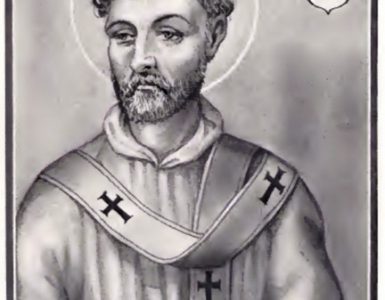A few years after the death of St. Catherine of Siena (1347-1380), the Lord gave His Church another great saint, St. Rita of Cascia. St. Rita was not born in Tuscany but in Umbria, in the Diocese of Spoleto, in 1381 and died in 1457. Both saints lived in a time of great turmoil within the Church: from the early 1300s, for about eighty years, the popes experienced the “Avignon captivity;” later, after their return to the Roman See, there were numerous other problems that were reflected in the life of St. Rita.
The fact that historical travails are connected with the lives of saints is certainly nothing new: just think of St. Rose of Viterbo who, at the time of the dispute in Naples between Pope Innocent IV and Emperor Frederick II, predicted the latter’s death in 1250. The struggles between the Ghibellines, supporters of the emperor, and the Guelphs, supporters of the Pope, marked a long historical era in Italy. For example, during the pontificate of Pope Boniface VIII, we see the close intertwining of politics and religion, as is also evident in Dante’s work. In the Divine Comedy, Dante marks the pinnacle of the medieval world, but in the Convivio and De Monarchia, he already shows the first signs of the mentality that would later become dominant, for example, in the work of Machiavelli. These signs can be perceived in Dante’s conception of the Papacy and monarchy itself. While not a separation of Church and State, as we see in the 1700s, it certainly did not favor the Papacy too much.
The Italy of the great cities, Florence, Bologna, Naples, Milan, Padua, etc., is already a very modern world by the 1300s—in the sense of “being secularized.” The great scholars were no longer just priests, friars, and monks, as was the case in France, England, and Germany at that same time. Moreover, among the tonsured were people like Petrarch (and others like him), who had taken holy orders just so he could teach at the University of Paris.
St. Rita was born in this very complex context to elderly parents. Going against her vocation, which was to enter a convent, she was given in marriage to a violent man, who would convert only shortly before being murdered. Their two sons were to avenge their father’s murder, adding sin to sin, but thanks to their mother’s prayers, they repented from their intent before their untimely deaths.
Saint Rita, having found herself alone in the world, tried to join the Augustinian nuns in Cascia. After numerous refusals, she was finally accepted and lived in religious life for 42 years.
There she lived a life of hidden charity which touched the multitudes of faithful in a time of great confusion. Such are the saints God sends to comfort us with His Truth and Love. Charity covers a multitude of sins, Saints James and Peter remind us in their epistles. This is what the saint of the impossible, St. Rita, would have taught the Church at a very difficult time of schism and lack of charity. Let us not forget that while the sin against faith is heresy, the sin against charity is schism.
The pope had returned from France to Rome in 1376 and, to recompose a serious schism, the Council of Constance held between 1414 and 1417 was necessary; after the Council, as an unintended consequence, so-called Conciliarism arose, which Pope Eugene IV in the 1430s had to counter with many difficulties in order to strengthen the Church and the Papacy. It is almost as if St. Catherine of Siena handed on the baton to St. Rita, even though St. Rita’s role was certainly not as directly involved in papal issues as St. Catherine’s was.
Moreover, at that time of serious upheaval, in 1453, there was the fall of Constantinople, with all the unforeseeable consequences that led to the rise of the Renaissance in Italy, which also had so much influence on the papacy. It is in these moments that God sends saints who are shining examples of every Christian virtue, pure as lilies, simple as doves, obedient as angels. Our Lord has shown how He works miracles through such saints. On one occasion, St. Rita asked that a rose be brought to her from her garden in the middle of winter. The rose was found in full bloom, somewhat like what happens every year in January at the Shrine of Our Lady of Flowers in Bra in Piedmont, a miracle that is still repeated today and confirmed by science.
Intercessory prayers to St. Rita for a miracle soon rose from all sides. This is how grace works, hidden but powerful, subtle as a growing garden, and not like the devil’s fireworks that leave, after so much light, nothing but smoke. On the contrary, grace gives life, light, peace, and joy, and this is the greatest result, being able to stop the weapons of a ruthless and hate-filled world, thanks to the symphony of love of Christ’s Passion.
The Passion of Christ marks the culmination of Charity, and Charity does indeed involve a certain amount of suffering. But the Passion is fulfilled anew every day in the Holy Mass. Therein also lies the secret of holiness: to remain close to Our Lord, as did St. Mary Magdalene, called by some the prophetess of Eucharistic love. St. Mary Magdalene is so attracted by the love of the Lord, by the warmth of the Sacred Heart, to the point of forgetting her own sinfulness and boldly approaching the Lord to anoint Him, shortly before His death, a year after the miracle of the multiplication of the loaves and fishes.
On the occasion of that miracle, it is interesting to remember that the Lord had said, “I am the bread of life,” and Judas at that moment does not understand what the Messiah is doing and saying, because he has a very political idea of the Messiah. Judas was, in a sense, one of the more “perfect” apostles, a kind of Jansenist, Pelagian, apostle who did everything himself and disagreed with what Jesus had said. A year later he sees this converted sinner anointing the Lord with oil of nard, which is the ointment with which the dead are anointed, and he is scandalized at the sight, turning in Our Lord to the authorities. Judas had not understood the New Law Christ promoted: the Interior Law of the conversion of the heart.
A nursing student of mine used this example to show the charity of the saints: if someone asks me to give some hand cream, I don’t pour the whole bottle on her hands, which is reasonable, but divine charity goes beyond what is reasonable and just. St. Mary Magdalene, who was forgiven so many sins, realized her imperfections, and in this sense, she is a prophetess of Eucharistic love. Judas, in contrast, did not realize his imperfections because he felt he was perfect.
The message of St. Mary Magdalene, the message of St. Rita of Cascia, the message of St. Catherine of Siena, the message of these prophetesses, of these women who understood the love of the Lord and the warmth of His Sacred Heart is a message of great love and great hope for many of us.
St. Mary Magdalene is so attracted by the love of the Lord and the warmth of the Sacred Heart that she forgets her own sinfulness, approaches the Divine Lord with courage and enthusiasm, anointing Him before His death. St. Thomas Aquinas said that Christ’s head symbolizes His divinity, while His feet symbolize His humanity; when we adore both we accomplish a mystical anointing of the Lord, without forgetting either humanity or divinity.
This union is most important and is a fundamental notion of the Church and Christology. For example, in the Monophysite perspective, refuted by the Council of Chalcedon, humanity is absorbed like a drop of water in the divine ocean. But this is not the message of Christ, which on the contrary consists in embracing humanity, in uniting it with divinity in its very being, a complex discourse, but one that saints like St. Mary Magdalene, St. Rita of Cascia, and St. Catherine of Siena understood in the Passion of Christ and in the Eucharist to continue to make Him present in the history of the Church.
Therefore, we must continue to have faith, hope, and charity because despite everything the Lord continues to be present, in Heaven at the right hand of the Father and on earth in the Most Holy Eucharist.
Let us spend much time with Him! For a heart in love, time spent with Jesus is never too much and is never wasted. I wish you all good things and that you can grow in holiness, which may seem impossible, and join the great saints, but especially the Eucharistic Lord.
Image from Meisterdrucke












